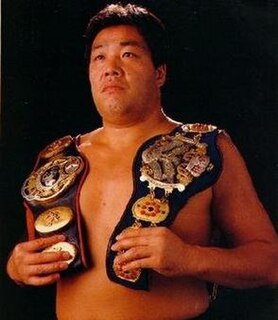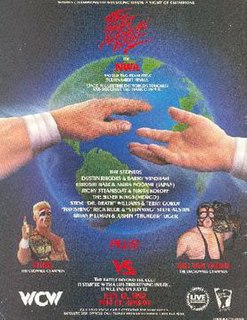
Mitsuharu Misawa was a Japanese amateur and professional wrestler and promoter. He is primarily known for his time in All Japan Pro Wrestling (AJPW), and also for forming the Pro Wrestling Noah promotion in 2000. In the early 1990s, Misawa gained fame alongside Toshiaki Kawada, Kenta Kobashi, and Akira Taue, who came to be nicknamed AJPW's "Four Pillars of Heaven", and whose matches developed the ōdō style of puroresu and received significant critical acclaim. Despite never working in the United States during the 1990s, Misawa had significant stylistic influence upon American independent wrestling, through the popularity of his work among tape-traders in the country. Misawa is regarded by some as the greatest professional wrestler of all time. However, the physical demands and consequences of the style in which he worked and the circumstances of his death have made his legacy, or at least that of ōdō, somewhat problematic.

Barry Clinton Windham is an American retired professional wrestler. The son of wrestler Blackjack Mulligan, he is best known for his appearances with the National Wrestling Alliance (NWA) and World Championship Wrestling (WCW).

Michael Seitz is an American retired professional wrestler and former musician. Seitz is best known for leading The Fabulous Freebirds under the ring name Michael "P.S." Hayes and for his role as an announcer under the name Dok Hendrix in the World Wrestling Federation (WWF). He is currently employed with WWE as Vice President, Creative Writing & Booking and is also a senior producer.

The NWA World Tag Team Championship is a professional wrestling world tag team championship created by the National Wrestling Alliance. From 1948 to 1982, the NWA allowed member promotions to create their own territorial version of the "NWA World Tag Team Championship" without oversight from the board of directors. The first of these NWA World Tag Team Championships was created in 1950 in the San Francisco territory, which while billed as a "World" title was essentially restricted to the specific NWA territory. In 1957 as many as 13 versions of the NWA World Tag Team Championship were confirmed to be in existence. In 1982 Big Time Wrestling, based in Los Angeles, closed and abandoned their version of the championship. The following year, the World Wrestling Federation, an NWA member at the time and which had its own World Tag Team Championship, split from the NWA in acrimony. This meant that only the Jim Crockett Promotions' NWA World Tag Team Championship was active within the NWA, but still being controlled by JCP, not the NWA board of directors. In 1991 that championship was renamed the WCW World Tag Team Championship.

Terry Ray Gordy Sr. was an American professional wrestler. Gordy appeared in the United States with promotions such as Mid-South Wrestling, Georgia Championship Wrestling, World Class Championship Wrestling, Jim Crockett Promotions/World Championship Wrestling and the Universal Wrestling Federation as a member of The Fabulous Freebirds. He also appeared in Japan with All Japan Pro Wrestling as one-half of The Miracle Violence Connection.

James Williams is an American retired professional wrestler, better known by his ring names "Gorgeous Jimmy" Garvin and Jimmy "Jam" Garvin. A member of The Fabulous Freebirds, Garvin is best known for his appearances with promotions including the American Wrestling Association, World Class Championship Wrestling, and World Championship Wrestling.

Steven Williams was an American professional wrestler, collegiate football player, and amateur wrestler at the University of Oklahoma. Williams was known as "Dr. Death", a nickname he acquired in junior high school.

John Stanley Hansen II is an American retired professional wrestler.

Genichiro Shimada, better known as Genichiro Tenryu is a retired Japanese professional wrestler and professional wrestling promoter. At age 13, he entered sumo wrestling and stayed there for 13 years, after which he turned to Western-style professional wrestling. "Tenryu" was his shikona. He had two stints with All Japan Pro Wrestling (AJPW), where he spent the majority of his career while also promoting Super World of Sports (SWS), Wrestle Association R (WAR) and Tenryu Project. At the time of his retirement, professional wrestling journalist and historian Dave Meltzer wrote that "one could make a strong case [that Tenryu was] between the fourth and sixth biggest native star" in the history of Japanese professional wrestling. He is a 5 times professional wrestling world champion.
Akira Taue is a Japanese retired professional wrestler. He is also a former All Japan Pro Wrestling Triple Crown Heavyweight Champion, a former GHC Heavyweight Champion and has had fourteen 5 Star Matches as awarded by the Wrestling Observer Newsletter.

Toshiaki Kawada is a Japanese semi-retired professional wrestler best known for his work in All Japan Pro Wrestling (AJPW), whom he worked for from his debut in 1982 up until 2008. In All Japan, he was a 5 time Triple Crown Heavyweight Champion, a 9 time World Tag Team Champion, three time winner of the Real World Tag League and a two time winner of the Champion Carnival. He was also recognised as the ace of the promotion from 2000–2005.

Tomomi "Tommy" Tsuruta, better known by his ring name Jumbo Tsuruta, was a Japanese professional wrestler who wrestled for All Japan Pro Wrestling (AJPW) for most of his career, and is well known for being the first ever Triple Crown Heavyweight Champion, having won the PWF Heavyweight Championship, the NWA United National Championship, and the NWA International Heavyweight Championship, and unifying the three titles. He is also known for being one-half of the first World Tag Team Champions with Yoshiaki Yatsu, having won the NWA International Tag Team Championship and the PWF Tag Team Championship, and unifying the two titles.
Marcus Laurinaitis is an American retired professional wrestler, better known by his ring name, The Wrecking Crew (Fury) & Terminator. He wrestled primarily in Florida (FCW), Japan, and Europe (CWA), as well with World Championship Wrestling (WCW). He is the brother of fellow professional wrestlers John Laurinaitis and Road Warrior Animal.

Masanobu Fuchi is a Japanese professional wrestler currently signed to All Japan Pro Wrestling (AJPW), where he is also a director and the co-head booker. Fuchi has exclusively worked for All Japan since his debut in 1974, and holds the record for the longest World Junior Heavyweight Championship reign at 1309 days. Fuchi became a freelancer in 2009, but officially re-signed with AJPW in 2013 as both a director and wrestler, making him the longest tenured member of the All Japan roster.
George Hines is a retired American professional wrestler, best known by his ringname Jackie Fulton, who competed in regional and independent promotions including the American Wrestling Association, East Coast Championship Wrestling, the National Wrestling Alliance, World Championship Wrestling and, most notably, his brief but memorable stint in Smoky Mountain Wrestling where he teamed with his real life brother Bobby Fulton as The Fantastics.
Richard Aslinger is a retired American professional wrestler, known by his ring name Richard Slinger. Slinger was a long-time mainstay of All Japan Pro Wrestling and later Pro Wrestling Noah, where he was one of two gaijin heels to compete in the promotion. He is also one of several Noah wrestlers to be featured in the Japanese video game King of Colosseum II.
The Holy Demon Army (HDA) was a professional wrestling tag team consisting of Toshiaki Kawada and Akira Taue. The HDA competed in All Japan Pro Wrestling during the 1990s and is considered the most successful and dominant team in the history of All Japan as they held the World Tag Team Championship a record six times, as well as having won the World's Strongest Tag Determination League on two occasions.
Revolution was a professional wrestling stable in All Japan Pro Wrestling (AJPW) led by Genichiro Tenryu.

The 1992 Great American Bash was the fourth annual Great American Bash professional wrestling pay-per-view event produced by World Championship Wrestling (WCW), and the eighth annual Great American Bash event overall. The event took place on July 12, 1992, at the Albany Civic Center in Albany, Georgia. It was the last Great American Bash held until 1995.
This is a list of Japanese professional wrestler Mitsuharu Misawa's championships and accomplishments. Misawa (1962-2009) debuted for All Japan Pro Wrestling (AJPW) in 1981, and began work as the second incarnation of the Tiger Mask gimmick in 1984. He achieved some success as the character, but when he unmasked mid-match in May 1990, Misawa was pushed to the top of the company, and became one of AJPW's most decorated wrestlers of the 1990s. When he led a mass exodus to start his promotion Pro Wrestling Noah, he continued to have great success until his death in an in-ring accident. Misawa also received significant critical acclaim from domestic and international publications throughout his career.